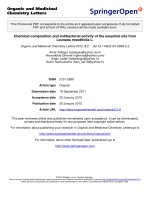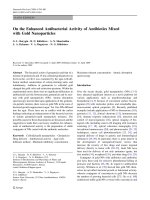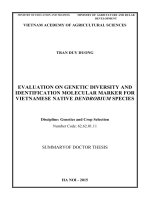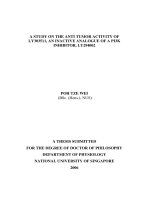Antibacterial activity of Piper betle extracts on Helicobacter pylori and identification of potential compounds
Bạn đang xem bản rút gọn của tài liệu. Xem và tải ngay bản đầy đủ của tài liệu tại đây (406.28 KB, 6 trang )
TAP CHI SINH HOC 2019, 41(4): 69–74
DOI: 10.15625/0866-7160/v41n4.13876
ANTIBACTERIAL ACTIVITY OF Piper betle EXTRACTS ON Helicobacter
pylori AND IDENTIFICATION OF POTENTIAL COMPOUNDS
Nguyen Thi Huyen Trang 1,*, Do Thi Thanh Trung 2*, Nguyen Thi Thanh Thi2, Pham Thi
Luong Hang2,3, Pham Thi Vinh Hoa1, Pham Bao Yen3,**
1
Laboratory Center, Hanoi University of Public Health, Ha Noi, Vietnam
2
Faculty of Biology, VNU University of Science, Ha Noi, Vietnam
3
The Key Laboratory of Enzyme and Protein Technology (KLEPT), VNU University of
Science, Ha Noi, Vietnam
Received 14 June 2019, accepted 5 October 2019
ABSTRACT
Helicobacter pylori is one of the most common infectious bacteria in the world that causes
gastric diseases leading to cancer. The increase of multiple antibiotic resistance rates of H. pylori
have been reported worldwide. Thus, development of novel drugs is urgently required. Piper
betle has many therapeutic values in traditional medicine. In this study, therefore, we investigated
antibacterial activity of P. betle extracts and their fractions against a H. pylori strain isolated in
Vietnam. The agar disk diffusion assay showed inhibition zone of ethyl acetate extract and
methanol extract from P. betle leaf that of were 46 mm and 32 mm in diameter, respectively.
After fractionation of the ethyl acetate extract through silica gel column chromatography, two
peaks, PD2 and PD3, out of 12 fractions showed the strongest antibacterial activity. PD2 was
sub-fractionated further by re-chromatography on the silica gel column, and subfraction TK12
gave best resolution on LC-MS analysis. Finally, 4 potential compounds, quercetrin, calodenin B,
vitexin and plicatipyrone, were identified in TK12 fraction.
Keywords: Helicobacter pylori, Piper betle, medicinal plants, gastric disease, compound.
Citation: Nguyen Thi Huyen Trang, Do Thi Thanh Trung, Nguyen Thi Thanh Thi, Pham Thi Luong Hang, Pham Thi
Vinh Hoa, Pham Bao Yen, 2019. Antibacterial activity of Piper betle extracts on Helicobacter pylori and
identification of potential compounds. Tap chi Sinh hoc (Journal of Biology), 41(4): 69–74.
/>*These authors are co-first authors
**Corresponding author email:
©2019 Vietnam Academy of Science and Technology (VAST)
69
Nguyen Thi Huyen Trang et al.
INTRODUCTION
H. pylori is one of the most popular
pathogens worldwide. According to the
United States Center for Disease Control,
approximately a half of the world’s population
is infected with H. pylori. Recent research
showed that H. pylori infection rate is still
high in most countries with variances among
geographical regions and different age groups
(Frenck et al., 2003). The prevalence of H.
pylori infection in developing countries such
as South America, Eastern Europe, and Asia
is higher than in developed countries such as
North Europe and North America. In some
coutries in Africa, more than 90% of adults
are identified positive for H. pylori (Eusebi et
al., 2014). According to the statistics, in
Vietnam, roughly 60–70% of the population
(about 56 millions) were infected with this
bacterium (Fock & Ang, 2010). Helicobacter
pylori infection has been treated with
combination of several antibiotics such as
amoxicillin, tetracycline, clarithromycin and
metronidazole. However, according to the
statistics, the antibiotic resistance of H.
pylori is increasing with presence of more
multidrug-resistant strains (Binh et al.,
2013). Thus, development of new drugs is an
urgent demand.
It should be noted that Vietnam has a rich
medicinal resource background for the
screening of natural compounds possessing
antibacterial ability against H. pylori. Among
those medicinal plants, Piper betle L in the
Piperaceae family has many therapeutic
values including wound healing and
antioxidant properties. P. betle leaf has been
used for the treatment of various diseases like
bad breath, boils and abscesses, conjunctivitis,
constipation, headache, itches, mastitis,
mastoiditis, leucorrhoea, otorrhoea, swelling
of gum, rheumatism, cuts and injuries. The
leaf has significant antimicrobial and
antifungal activities against many pathogens
(Ali et al., 2010; Agarwal et al., 2012). The
Indian traditional medicine identified P. betle
leaves has digestive and pancreatic lipase
stimulant activities (Prabhu et al., 1995).
Besides, P. betle leaf can inhibit progression
70
of gastric ulceration, helping in the faster
healing (Arawwawala et al., 2014). Thus, in
this study, we aimed to examine antibacterial
activity against H. pylori and identify
potential compounds to develop anti-H. pylori
drugs from the P. betle leaf.
MATERIALS AND METHODS
Preparation of P. betle leave extracts
Piper betle leaves were collected, then
dried at 40 oC and stored at 4oC. The leaves
were extracted in ethyl acetate and methanol
solvents following the procedure described in
a previous study (Pham et al., 2017). Firstly,
the powdered leaf part (5 g) was homogenized
in 100 mL ethyl acetate using a mortar and
pestle, followed by sonication for 5 min and
stirring for 60 min at room temperature. The
homogenate was centrifuged at 5,000 × g for
10 min at 10°C and the supernatant was
collected by filtration. The residue was
extracted once again with 100 mL ethyl
acetate and all supernatants were combined to
obtain the ethyl acetate extract. Then the dried
residue was successively extracted twice with
100 mL methanol with the same procedure to
get a methanol extract. The organic solvents
were removed by vacuum rotary evaporation.
The dried extracts were weighed and stored at
-20oC until use.
Isolation of Helicobacter pylori strains and
cultivation
Biopsies were stained with Giemsa
agents to specify the presence of H. pylori
bacteria. Positive samples were crushed by
pestle blades and implanted in 5% sheep
blood and selective antibiotics for
Helicobacter pylori selective supply. Agar
plates were incubated at 37oC under an
aerobic condition created by the GasPakTM
environmental bag (Becton, Dickinson
and Company, USA). Results were read
after 7 days with the appearance of small,
transparent colonies with diameter of 1–
2 mm. Tests used to identify H. pylori
bacteria including Gram staining, the ability
to produce urease, catalase, oxidase, and
PCR with H. pylori -specific lipase primers.
Antibacterial activity
Column chromatography
In the first step, 25 g of silica gel was
saturated in the first solvent system (50% nhexane: 50% ethyl acetate) and was packed
into a column. The ethyl acetate extract (200
mg) was applied on the top of silica gel. The
components of extract were continuously
eluted by six solvent systems with increasing
polarity including 50% n-hexane: 50% ethyl
acetate, 30% n-hexane: 70% ethyl acetate,
90% ethyl acetate: 10% methanol, 60% ethyl
acetate: 40% methanol, 30% ethyl acetate:
70% methanol, and 100% methanol. The
eluents were collected in tubes (3 ml/ tube)
as a serial 12 fractions designted from PD1
to PD12.
In the second step, the PD2 fraction was
further fractionated by subsequent silicagel
column chromatography. An amount of 85
mg of PD2 fraction was loaded for onto the
column and continuously eluted by six other
solvent systems including 100% n-hexane,
70% n-hexane: 30% ethyl acetate, 50% nhexane: 50% ethyl acetate, 30% n-hexane:
70% ethyl acetate, 100% ethyl acetate, and
50% ethyl acetate: 50% methanol. The
eluents were collected in tubes (3 ml/ tube)
as a serial 12 sub-fractions designated from
TK1 to TK12.
TLC chromatogram of 12 sub-fractions
In this experiment, silica gel 60 F254 TLC
Sheets (6.5 cm × 10 cm) were used as a
stationary phase. An amount of 0.5 mg of
each sub-fraction (TK1-TK12) was loaded on
TLC. The TLC was then devoloped in solvent
systems of 60% n- hexane: 40% ethyl acetate
as mobile phase. Patterns on the TLC
chromatogram were detected at 254 nm, 356
nm UV light (UVP Lamp, Cambridge, UK).
Liquid chromatography-mass spectrometry
(LC-MS)
High performance liquid chromatography
(HPLC) coupled with mass spectrum was
used to identify potential compounds in the
active fraction. An amount of 3 µl samples
was injected into C18 - RP column (4.6 ×
250 mm, Phenomenex, USA) and separated in
a gradient of 78–92% MeOH in deionized
water for 37 min. The measurements were
carried out at the Institute of Pharmaceutical
Biology, University of Greifswald, Germany.
Determination of antibacterial activity
Agar diffusion method was performed as
per Mitscher et al. (1972) with slight
modifications (Mitscher et al., 1972). The
dried extract was dissolved in DMSO to
obtain a solution of 200 mg/ml. Prior to the
test, 20 μl of extract (200 mg/ml) was added
to the paper disc and air-dried for 3 hr.
Helicobactor pylori was mixed into a
suspension of the McFarland turbidity of 2
(OD625nm = 0.451, approximately 6×108
CFU/ml) and streaked on a surface of blood
agar plate. After that, the paper disc was
placed on the surface of bacteria and
incubated under a microaerophilic condition
at 37oC. Antibacterial zones were measured 5
days later.
RESULTS AND DISCUSSION
Antibacterial activity of the extracts
The ethyl acetate extract from Piper betel
leaves has 1.5 times stronger anti-bacterial
activity against H. pylori compared to the
methanol extract (46 vs. 32 mm inhibition
zone diameter, respectively). This result is
comparable with the previous publication of
the inhibitory effect of P. betle leaf extract
against H. pylori (Nguyen Van Toai, 2003).
Therefore, the ethyl acetate extract of
the P. betle leaf was selected for further
isolation of active compounds using
chromatography method.
Antibacterial activity of silica-gel column
chromatography fractions
After silica-gel column chrpmatograpy of
the ethyl acetate extract, 9/12 fractions had
antibacterial activity against H. pylori with
diameter ≥ 10 mm (figure 1).
In detail, 12 fractions can be divided into
4 groups based on H. pylori inhibitory activity
by the diameter of inhibition zone (IZD): no
activity (PD1); the weak group with IZD < 10
71
Nguyen Thi Huyen Trang et al.
mm (PD6 and 7 fraction); moderate group
with IZD range of 10–30 mm (PD 4, 5, 8–12);
the strong group with IZD fluctuating > 30
mm (PD2, 3). Apparently the antibacterial
activity against H. pylori is localized mainly
in fraction PD2 followed by PD3. Thus, PD2
fraction was analyzed further to find
antibacterial compounds against H. pylori.
Figure 1. Antibacterial activity of 12 fractions against H. pylori
Identification of potential antibacterial
compound in Piper betle leaf
Sub-fractionation of PD2 fraction
Before LC-MS analysis, PD2 fraction
was fractionated further into sub-fractions by
silica gel column chromatography. From
85 mg of PD2 fraction, 12 sub-fractions
(TK1-TK12) were collected after elution
with 6 solvent systems. TLC analysis
(figure 2) revealed that 12 sub-fractions were
different from each other with distinct TLC
patterns. All of these sub-fractions were
analysed using LC-MS.
Figure 2. TLC chromatogram of 12 fractions at 254 nm
Identification the potential compounds in
TK12 fraction
All of 12 sub-fractions (TK1-TK12) were
analyzed by analytical HPLC with detection at
190 nm in 37 min. The chromatograms of 12
sub-fractions were overlayed and shown in
Figure 3a. Among 12 fractions, TK12 fraction
72
gave the best spectrophotometric signal of its
components. There were 8 peaks eluated at
the corresponding time of minute 2, 5, 12.5,
13.2, 15.5, 18.5, 20.5 and 23 (Figure 3a),
which were analyzed on MS. MS of TK12
fraction at 13.2 min indicated the occurrence
of 5 pairs of compounds with 16 Da intervals
in molecular mass.
Antibacterial activity
(a)
(b)
Figure 3. (a) Overlay HPLC chromatograms of 12 sub-fractions (TK1-TK12), (b) Mass
spectrum of compounds appeared at 13.2 min in negative mode. Molecular weight of
each peak is given as a blue fonts
We determined two potential compound
groups including Group 1 with molecular
weight ranging from 274.5–306.4 Da and
Group 2 from 418.3–450.2 Da. The
compounds in each group were divided into
pairs with 16 Da apart such as Group 1
including 2 pairs: 274.5–290.4 and 290.4–
306.4, Group 2 including 3 pairs: 418.3–
434.3, 432.3–448.3 and 434.3–450.2. The
investigation of compounds based on the
library of natural products identified 4
compounds as shown in figure 4.
Figure 4. Prediction of potential compounds
These compounds, including quercetrin,
MW of 448; calodenin, MW of 524; vitexin,
MW of 434; plicatipyrone, MW of 418, were
previously extracted from other plants with
strong antibacterial activity, and also included
in the list of compounds from P. betle leaf
(Pradhan et al., 2013; Snow et al., 2016;
Ghosh et al., 2014; Tang et al., 2003). Yet,
none of those compounds has investigated
their anti-H. pylori activity.
CONCLUSION
Ethyl acetate extract of P. betle leaf
sample had strong anti-H. pylori activity with
diameter of inhibition zone of 46 mm. Two
consecutive fractionations of this extract using
silica gel column chromatography yielded 12
fractions and the anti-H. pylori activity was
concentrated in PD2 fraction. By the second
run of the column chromatography, 12 subfractions (TK1-TK12) from PD2 fraction with
the first column. Among sub-fractions, TK12
gave the best resolution in the component
analysis by LC-MS, in which 4 potential
compounds have been predicted to be
quercetrin, calodenin B, vitexin and
plicatipyrone.
Acknowledgements: This study received
funding from the National Foundation for
73
Nguyen Thi Huyen Trang et al.
Science and Technology Development
(NAFOSTED) with the code: 106-NN.022013.55. We kindly thank to Dr. Simon
Merdivan (Institute of Pharmaceutical
Biology, University of Greifswald, Germany)
for LC-MS measurements. We thank the Key
Laboratory of Enzyme and Protein
Technology, VNU University of Science for
providing research facilities.
Frenck Jr, R. W., Clemens, J., 2003.
Helicobacter in the developing world.
Microbes and infection, 5(8): 705–713.
REFERENCES
Agarwal A. K., Tripathi S. K., Xu T., Jacob M.
R., Li X.-C., Clark A. M., 2012. Exploring
the molecular basis of antifungal synergies
using
genome-wide
approaches.
Frontiersin Microbiology, 3: 115.
Ali I., F. G. Khan, K. A. Suri, B. D. Gupta, N.
K. Satti, P. Dutt, F. Afrin, G. N. Qazi, I.
A. Khan, 2010. In vitro antifungal activity
of hydroxychavicol isolated from Piper
betle L. Annals of clinical microbiology
and antimicrobials, 9(1): 7.
Arawwawala, L. D. A. M., Arambewela, L. S.
R., Ratnasooriya, W. D., 2014.
Gastroprotective effect of Piper betle
Linn. leaves grown in Sri Lanka. Journal
of Ayurveda and integrative medicine,
5(1): 38.
Binh T. T., S. Shiota, L. T. Nguyen, D. D. Ho,
H. H. Hoang, L. Ta, D. T. Trinh, T.
Fujioka, Y. Yamaoka, 2013. The
incidence of primary antibiotic resistance
of Helicobacter pylori in Vietnam.
Journal of clinical gastroenterology,
47(3): 233.
Chinou I. B., V. Roussis, D. Perdetzoglou, O.
Tzakou, A. Loukis, 1997. Chemical and
Antibacterial Studies of two Helichrysum
Species of Greek Origin1. Planta medica,
63(02): 181–183.
Eusebi L. H., R. M. Zagari, F. Bazzoli, 2014.
Epidemiology of Helicobacter pylori
infection. Helicobacter, 19(s1): 1–5.
Fock K. M., T. L. Ang, 2010. Epidemiology
of Helicobacter pylori infection and
gastric cancer in Asia. Journal of
gastroenterology and hepatology, 25(3):
479–486.
Hang T. L. Pham, Lien T. T. Nguyen, Tuan A.
Duong, Dung T. T Bui, Que T. Doan, Ha
T. T. Nguyen, Sabine Mundt, 2017.
Diversity and bioactivities of nostocacean
cyanobacteria isolated from paddy soil in
Vietnam.
Systematic
and
Applied
Microbiology, 40: 470–481.
74
Ghosh R., K. Darin, P. Nath and P. Deb., 2014.
An overview of various Piper species for
their biological activities. International
Journal of Pharmaceutical Sciences
Review and Research, 3(1): 67–75.
Mitscher L. A., Leu R. P., Bathala M. S., Wu
W. N., Beal J. L., 1972. Antimicrobial
agents from higher plants-I: introduction,
rationale and methodology. Lloydia, 35:
157–166.
Nguyen Van Toai, 2003. Initial study of antiHelicobacter pylori by total extract from
Piper betle in in vitro and pre-clinical
trial, PhD Thesis.
Prabhu M., K. Platel, G. Saraswathi,
Srinivasan, K., 1995. Effect of orally
administered betel leaf (Piper betle Linn.)
on digestive enzymes of pancreas and
intestinal mucosa and on bile production
in rats. Indian journal of experimental
biology, 33(10): 752–756.
Pradhan D., K. Suri, D. Pradhan, Biswasroy,
P., 2013. Golden Heart of the Nature:
Piper betle L. Journal of Pharmacognosy
and Phytochemistry, 1(6): 147–167.
Snow Setzer M., J. Sharifi-Rad, Setzer, W. N.,
2016. The Search for Herbal Antibiotics:
An In-Silico Investigation of Antibacterial
Phytochemicals. Antibiotics, 5(3): 30.
Tang S., P. Bremner, A. Kortenkamp, C.
Schlage, A. I. Gray, S. Gibbons, M.
Heinrich, M., 2003. Biflavonoids with
cytotoxic and antibacterial activity from
Ochna macrocalyx. Planta medica,
69(03): 247–253.









